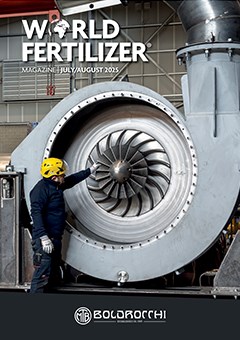Editorial comment
When I was a child and I thought about the future, I envisaged flying cars, meals in the form of tiny tablets, and robot pet dogs – the classic ‘Back to the Future’ style ideations. I gave very little thought to a sustainable future; a sustainable way of living. However, in a world where the global population is exponentially increasing, the climate is rapidly changing, and food security is a growing problem (excuse the double-entendre), it seems only prudent that, as a society, we direct more consideration towards the future of fertilizer.
Register for free »
Get started now for absolutely FREE, no credit card required.
Anglo American’s recently published ‘Future of Fertilizer’ report showcases the opinions of a varied range of experts from around the globe, when asked to express how they thought life would have changed by 2050, and what would be required of the fertilizer industry in order to successfully and sustainably feed the world.1 Three key take-aways from this include an increased focus on soil health and the need for fertilizers that support this, scalable and innovative infrastructure and production, and aligning global pressure with sustainability goals.
Low-carbon initiatives have become an increasing part of both business and government campaigns in recent years. Fertilizer production and application is responsible for 2.6 Gt/yr of CO2e, equating to more than aviation and shipping industries combined.2 Not only this, but the knock-on effect of this is increased soil acidity, leading to depleted crop yields – exacerbating the issue of food security through inadequate soil quality. This only emphasises the need to reduce CO2 emissions.
Scalable infrastructure is imperative to economic growth. Low-carbon fertilizers could be the golden ticket when it comes to fast and scalable opportunities to decarbonise the industry, and uptake in this requires collaborative investment across the value chain. The production of low carbon fertilizers, utilising renewable ammonia for example, can reduce greenhouse gas (GHG) emissions created by fertilizer production by up to 95%.3
Aligning governmental and sustainability goals is a sure-fire way of overcoming challenges related to the longevity of the fertilizer industry. COP29 emphasised the need for sustainable fertilizer practices to be adopted worldwide. With the COP30 summit taking place in November of this year, it will be interesting to see what developments have been discussed and implemented a year on, and if there are any further plans for increased action.
The future is an exciting yet daunting concept to grasp in a world where change is occurring daily, and is often out of our control. I no longer look to the future with child-like wonder and naivety. Instead I feel it is important to think pragmatically about what the future holds. The concept of ‘living sustainably’ should be seen as an exciting challenge to undertake. One that both individuals and groups should take on with open minds.
The July/August issue of World Fertilizer magazine features a cover story from Boldrocchi detailing how to boost fertilizer plant performance with advanced fans and centrifugal compressors. As well as this, there are key features on the topics of plant safety and inspection, HTHA, automation and process control, turbomachinery, catalyst recovery, and much more!
- https://uk.angloamerican.com/futureoffertiliser
- https://www.carbonchain.com/blog/understand-your-synthetic-fertilizer-emissions
- https://www.euractiv.com/section/agriculture-food/opinion/scaling-low-carbon-fertilizers-agri-food-sector-calls-for-eu-support/


